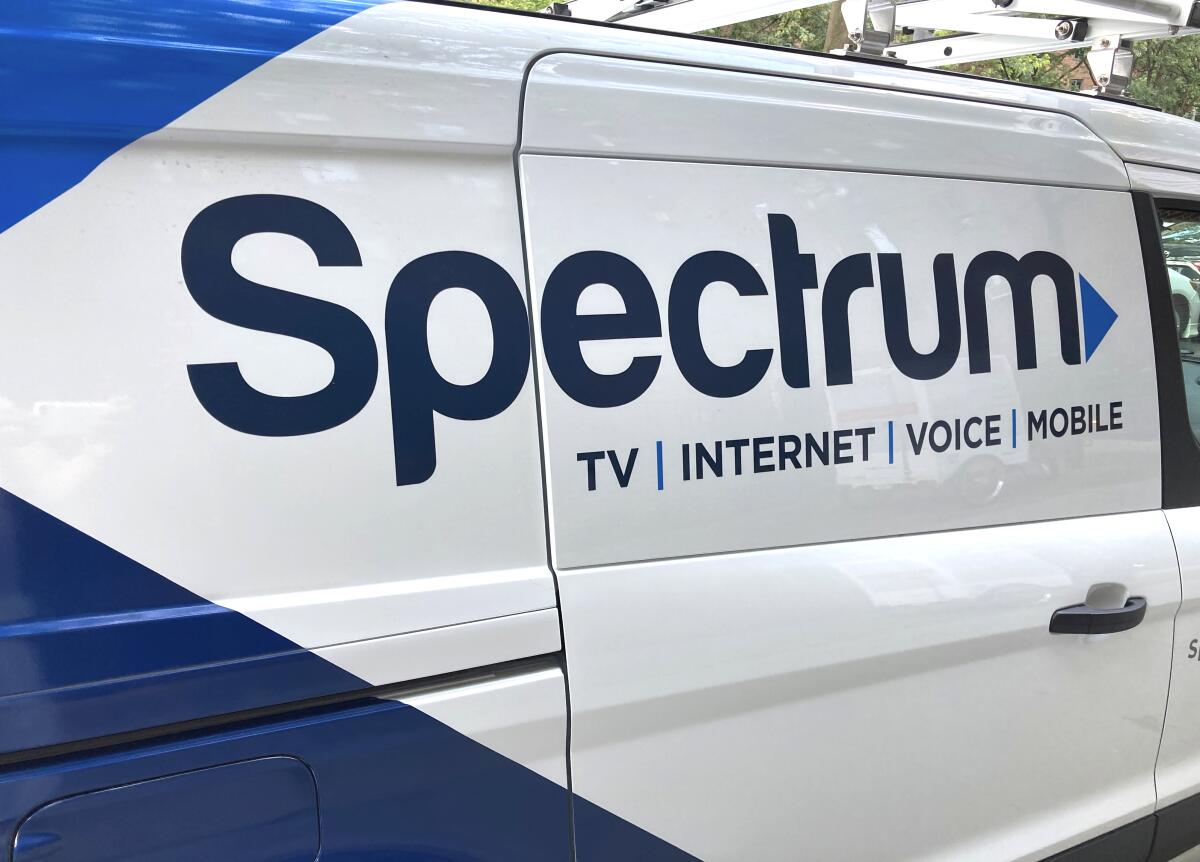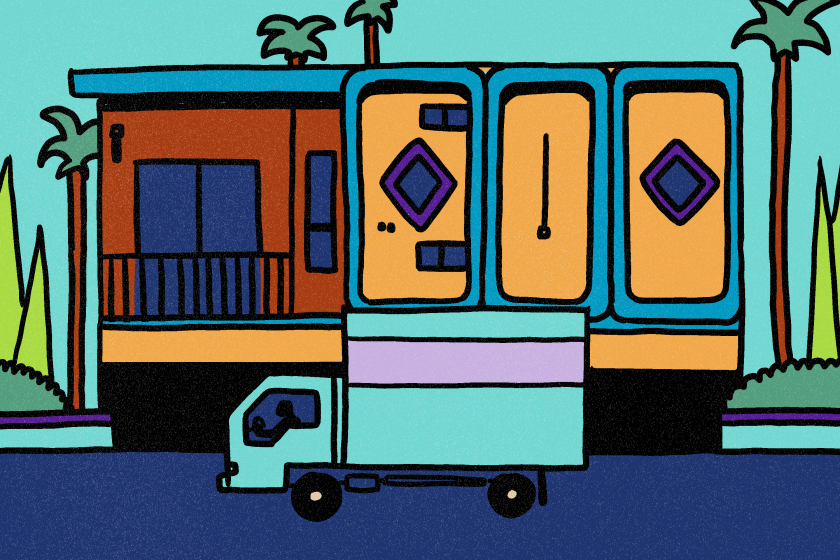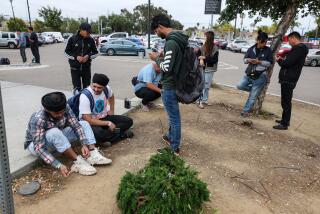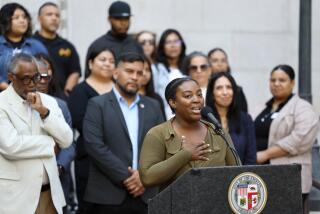You can get free broadband in L.A. if you’re a lower-income consumer. Here’s what to ask for

Tim Hebb lives in one of more than 1.6 million households in Los Angeles that qualify for a new federal subsidy program for high-speed internet service. And according to the Biden administration, he ought to be able to use that $30-a-month subsidy to get free access — 20 of the largest U.S. broadband providers had agreed to provide connections with up to 100 megabits-per-second download speeds for no more than the subsidy amount.
And in fact, Hebb did line up a free broadband connection from Spectrum, the cable TV operator serving most of Los Angeles County, but it wasn’t easy. Broadband advocates say that they’re hearing complaints from other consumers too who’ve been frustrated in their efforts to use the new Affordable Connectivity Program subsidies.
The hurdles are one factor behind the low percentage of qualified Californians who are using the Affordable Connectivity Program subsidies: 28% statewide, and 32% in L.A. County. Another factor, though, is that the subsidies aren’t well publicized. Some internet service providers tout them on their websites, but if you don’t have an internet connection, you can’t see those promotions.
To raise awareness, state and local officials, consumer advocates and a number of the larger internet service providers plan to step up the outreach in August. The effort will include delivering information about the Affordable Connectivity Program directly to households participating in Medi-Cal, CalFresh and the National School Lunch Program, which automatically qualify for the broadband subsidy.
But back to Hebb. He lives in an apartment building served by AT&T’s digital subscriber line service, which Hebb said maxes out at about 6 Mbps. The main alternative there is Spectrum, but when he checked the cable company’s broadband page, the least expensive offer was a $50-per-month, 300 Mbps connection.
Hebb kept at it, knowing from a separate page on Spectrum’s site that the company offers a $30, 100 Mbps tier to people who qualify for the Affordable Connectivity Program. He called the customer service line, where a representative “pilfered 15-20 minutes of my life that I’ll never get back trying to sell me a $105+ bundle of services after I explicitly asked for the ACP-compatible Internet 100 plan for $30/ month,” he said in an email.
The representative eventually told him that the $30 plan was “not available,” Hebb said, so he sent an email about his situation to a reporter and to Spectrum. He soon got a call from a Spectrum sales manager in San Antonio who seemed eager to set him up with the $30 plan. But “as the 21-minute call proceeded and he began processing the order,” Hebb wrote in an email, the manager “had to walk back the offer and finally ended up confirming the results of my first two efforts to get the deal — it’s NOT available in SoCal because the minimum speed available here is 300 Mbps, not 100 Mbps.”
The biggest internet service providers in California have all agreed to provide free broadband to low-income households. Now the challenge will be getting them to sign up.
As it happened, that wasn’t true. The sales manager called Hebb back Thursday with good news: He’d arranged for Hebb to get the service Spectrum offers to Affordable Connectivity Program households. “I didn’t bother to ask if this deal is available to anyone in SoCal who qualifies for the ACP,” Hebb said in an email. “I think this is a ‘squeaky wheel’ deal, to be frank.”
Dennis Johnson, a spokesman for Spectrum, said that the $30-a-month deal is available to any qualified household in Southern California, not just Hebb. He pointed to the Spectrum website’s home page, which touts the Affordable Connectivity Program in a banner across the top and links to a page where you can check your eligibility. In fact, when you call Spectrum’s customer service line now, a recorded message tells you about the program while you wait to speak to a representative.
Plenty of consumers have encountered customer service representatives who don’t know what their own company is offering. Still, Sunne Wright McPeak, president and chief executive of the California Emerging Technology Fund, said internet service providers do seem to be trying to upsell people who qualify for the Affordable Connectivity Program into more expensive tiers as they shift their services toward higher speeds.
Said Hebb, “I just wonder how many ACP-approved potential subscribers are actually able to get net-zero-dollar service from any of the self-described ‘participating’ providers. There are so many barriers and hurdles that make these offers effectively bait-and-switch schemes, I think most people would give up.”
For their part, Cox, Comcast, Frontier and AT&T all say they offer Affordable Connectivity Program-eligible households in California services with up to 100 Mbps downloads (with AT&T’s technology, the length of the subscriber’s connection affects the data speed) at no out-of-pocket cost. Cox also has a discounted service aimed at families with K-12 students in the home, offering a 100 Mbps connection for $10 a month.
Starry offers a $30-a-month, 100 Mbps version of its high-speed fixed wireless service in the locations it serves, but T-Mobile and Verizon do not. Instead, T-Mobile offers a discounted wireless data plan for smartphones, and Verizon offers a $30-a-month, 300 Mbps service to customers on its wired Fios networks on the East Coast.
The bigger issue, McPeak said, is how poorly the subsidies have been advertised. Promoting the discounts can make a huge difference, she said — a push L.A. County officials made with the California Emerging Technology Fund in December increased sign-ups by about 40%.
That’s why the state departments of Technology and Education, the state library, the California State Assn. of Counties and the California Emerging Technology Fund are making a coordinated outreach effort in August, culminating Aug. 27 with Affordable Connectivity Program enrollment events across the state that will provide hands-on help with applications. Signing up for the subsidies can be a challenge for people who can’t afford internet service, McPeak said, given that you have to apply online.
Supply shortages have sent used-car prices soaring. And that’s made repos more lucrative, with borrowers having cars seized days after missing a payment.
How to tell if you’re eligible
The Affordable Connectivity Program subsidies are available to any household earning no more than 200% of the federal poverty level, which is tied to the size of the household. For a single individual, the threshold is $27,180 this year. For a family of four, it’s $55,500.
But there’s an easier way to check your eligibility: You qualify for the program if anyone in your household is enrolled in at least one of 10 types of safety net programs, including CalFresh, Medi-Cal, Supplemental Security Income, Pell grants and federal public housing subsidies. Recipients of selected tribal benefit programs also qualify, and subsidies on tribal lands are higher: $75 a month.
To see whether you qualify or to submit an application, you can visit the White House’s “Get Internet” web page, which can walk you through the process. A mail-in application is available on the Get Internet site as well; it can also be found at the Affordable Connectivity Program’s how-to-apply page. All those resources, though, require internet access and a computer, tablet or smartphone.
If you have questions about how to apply but don’t have internet access, you can call the program’s help center toll-free: (877) 384-2575. Guidance is offered in English and Spanish.
Affordable housing, such as Section 8 and public housing, is available, but it often requires navigating applications and government agencies. Here’s what you need to know.
Once your application is approved, the subsidies will flow directly to the participating broadband provider of your choice. To find one in your area, check the program’s list, which you can search by ZIP Code or city. The list includes more than 90 participating providers near Los Angeles, although many of those are companies reselling service on one of the major wireless networks.
If you already have internet access, your broadband provider may have its own application process for the subsidies. You should start by checking with your internet service provider.
The Affordable Connectivity Program has no expiration date, but Congress can decide at any point to cut off funding.
About The Times Utility Journalism Team
This article is from The Times’ Utility Journalism Team. Our mission is to be essential to the lives of Southern Californians by publishing information that solves problems, answers questions and helps with decision making. We serve audiences in and around Los Angeles — including current Times subscribers and diverse communities that haven’t historically had their needs met by our coverage.
How can we be useful to you and your community? Email utility (at) latimes.com or one of our journalists: Jon Healey, Ada Tseng, Jessica Roy and Karen Garcia.










